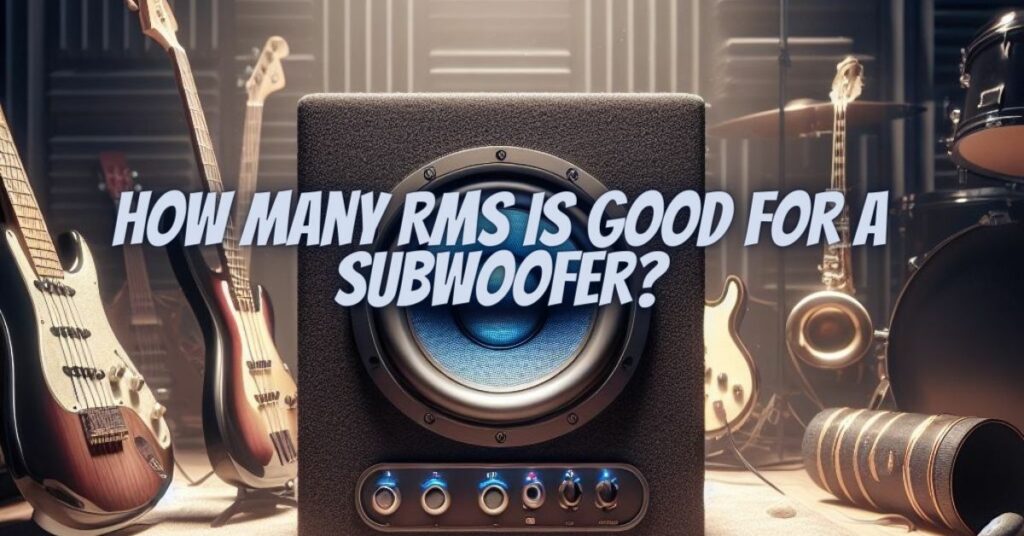Selecting the right subwoofer for your audio system is a pivotal decision that can significantly impact your listening experience. A key specification to consider when choosing a subwoofer is its RMS (Root Mean Square) power rating. RMS power represents the continuous power handling capability of a subwoofer and plays a crucial role in determining its performance. In this comprehensive article, we will explore how to determine the appropriate RMS watts for a subwoofer, taking into account factors such as room size, listening preferences, and overall system balance.
Understanding RMS Power for Subwoofers
Before delving into the question of how many RMS watts are good for a subwoofer, it’s essential to grasp the concept of RMS power:
- RMS Power (Root Mean Square): RMS power is a measurement of the continuous or sustained power handling capacity of an audio component, such as a subwoofer. It indicates the amount of power the subwoofer can handle without distortion or damage over an extended period.
- Peak Power: Peak power, often listed alongside RMS power, denotes the maximum instantaneous power a subwoofer can handle for very short bursts. Peak power is not a reliable indicator of continuous power handling and does not reflect real-world performance.
Factors Influencing Subwoofer RMS Watts
Several factors influence how many RMS watts are suitable for a subwoofer in your audio system:
- Room Size: The size of your listening space significantly impacts the perceived performance of your subwoofer. Larger rooms may require subwoofers with higher RMS power ratings to fill the space with deep, impactful bass.
- Listening Preferences: Your personal listening preferences are crucial. If you enjoy bass-heavy music genres, high-impact movie soundtracks, or high-volume listening, you may require a subwoofer with more RMS watts.
- Sound Quality vs. Volume: Consider whether you prioritize sound quality or sheer volume. Some listeners may prefer accurate and tight bass, while others may prioritize chest-thumping, high-volume bass.
- Crossover Settings: The settings of your subwoofer’s crossover (frequency at which it operates) and phase alignment with your main speakers can affect the perceived bass performance. Proper calibration can maximize the effectiveness of your subwoofer.
- Subwoofer Placement: The placement of your subwoofer in the room can impact its performance. Experimenting with different positions can help optimize bass response without necessarily requiring a higher RMS power rating.
Determining the Right RMS Watts
To determine how many RMS watts are good for a subwoofer in your audio system, consider the following steps:
- Assess Room Size: Measure your listening room’s size and volume. Larger rooms generally require subwoofers with higher RMS power ratings to achieve adequate bass coverage.
- Define Listening Preferences: Consider your listening preferences and the types of content you enjoy. If you seek powerful, impactful bass, you may need a subwoofer with higher RMS watts.
- Evaluate Subwoofer Placement: Experiment with different subwoofer placements in your room to optimize bass response. Proper placement can improve bass performance without the need for a higher RMS rating.
- Consider System Balance: Ensure that your subwoofer’s RMS power rating is well-matched to the rest of your audio system. Balance among components is crucial for overall audio quality.
- Room Acoustics: Assess the acoustics of your room and consider acoustic treatments if needed. Proper room treatment can enhance bass performance.
- Quality vs. Quantity: Prioritize the quality of bass over sheer quantity. A well-matched, high-quality subwoofer can provide satisfying bass response at lower RMS power ratings.
Determining how many RMS watts are good for a subwoofer involves a thoughtful assessment of factors such as room size, listening preferences, system balance, and room acoustics. Rather than solely focusing on higher RMS power ratings, aim for a subwoofer that complements your audio system and enhances your listening experience.
By carefully considering your specific needs and preferences, experimenting with placement and calibration, and prioritizing overall system balance, you can find the perfect subwoofer with an RMS power rating that delivers deep, accurate, and satisfying bass for your audio system.


